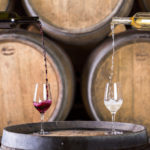CULINARY
Slovenia is a European Region of Gastronomy 2021. Here is why:
Slovenian cuisine is as rich and diverse as its folk customs and traditions. This is reflected in its gastronomic heritage and a variety of local and traditional produce and food. Traditional recipes and illustrious dishes, innovative gastronomic creators, superior wine producers and excellent chefs all make Slovenia a great destination for an unforgettable adventure. A meat-lover or a vegetarian/vegan, a foodie or a tourist, a wine connoisseur or just a beer-drinker can all enjoy an amazing assortment of all sorts of culinary delights and gastronomic experiences. Ranging from savoury cold-cut meats and sausages, creamy and hard cheeses, extra virgin olive oil and pumpkin oil, to sweet natural honey and hearty desserts, excellent wines and craft beers; Slovenian cuisine offers something for everyone. And everyone loves and respects what Slovenia and its people have to offer to the world. Award-winning chefs (Janez Bratovž, Ana Roš, Tomaž Kavčič, Andrej Kuhar and others), numerous premier wine producers and EU Protected Geographical Status quality stamps play a major role in the recognition and prominence of Slovenian foods and cuisine worldwide.
Here are some of the most famous Slovenian foods
- Kraški Pršut or Karst Prosciutto Ham
Kraški pršut is dry-cured meat, made out of fresh whole pig thighs. Its geographical origins are in the Karst Region of south-west Slovenia. The specialty of the dry-curing process lies in the exclusive use of the coarse sea salt, as the curing agent. The dry-curing process lasts about a year, which allows the meat to develop unique sensory properties, due to greater dehydration and smaller water content. Favourable climate conditions influence the dynamics of dry-curing process, giving Kraški pršut a distinctive colour and texture. It is a tasty, salty meat treat usually served as an appetizer dish.
- Kranjska Klobasa or Carniolan Sausage
Kranjska klobasa is one of the most widely recognizable Slovenian culinary products, both at home as well as abroad. It is a hot-smoked, semi-finished meat, made of coarsely ground pork and bacon (neck, back and thigh). The sausage filling is spiced exclusively with garlic and pepper, stuffed in natural small pig intestine casings. Kranjska klobasa is usually enjoyed after a short warm-up in hot water, where it obtains a very specific edible and high-quality gastronomic quality. Often combined with sauerkraut or sour turnip, and served with a bread roll, makes for a hefty and delicious meal. The sausage comes from Carniola Region of Slovenia.
- Prekmurska Gibanica or Prekmurje Layer Pastry
The recipe for Prekmurska gibanica is traditionally passed down from generation to generation. Its special method of preparation requires a lot of skills, accuracy and knowledge. The basis of the dish is made out of the layer pastry, including four different layers of ingredients twice, in the same exact order – poppy seeds, quark, walnut and apples. In the middle and on the top there is a layer of phyllo dough. The dish is typically covered with sour or sweet cream, combined with egg yolk or simply with natural fat dressing. Prekmurska gibanica originates from the Prekmurje Region of Slovenia and dates back to the early 19th century. Rich, tender and full of taste, the dessert is a definite must-try when visiting Slovenia.
- Potica or Nut Roll
Slovenian potica comprises a rolled pastry made of leavened paper-thin dough filled with any of a great variety of fillings, but most often with walnut filling. The most characteristic poticas are made with ground walnut, tarragon, quark, hazelnut, pumpkin seed or poppy seed. It is baked always in the special shaped potica baking mold (ceramic, glass or tin one), called potičnik, as a festive food every Easter and Christmas.
- Idrijski Žlikrofi or Idrija Dumplings
Idrijski žlikrofi are a traditional dish made of similar but a bit thinner dough as pasta. The dumplings are filled with potato stuffing, including potatoes, minced lard or smoked bacon, onions, spices and herbs. The dumplings have a characteristic hat-shaped form, with corners rolled up and the middle pressed down, creating a dimple or a hat shape. The dish is served both as an appetizer or a main course, served with another specialty from Idrija – bakalca, a dish made of mutton meat and vegetables. Idrijski žlikrofi originate from the town of Idrija, located in the western Slovenia. The dumplings are a savoury and a hearty dish, tasty to enjoy any time of the year.
And here are some of the most famous Slovenian wines:
- Teran or Terrano
Teran is red, thick wine, one of the most important products of the Karst soil, also known as “terra rossa” or “jerina”. It is a genuine Slovenian wine with designated origin, produced from Refosco vine grapes. The medicinal characteristics of Teran are the result of its various mineral substances and lactic acids, but it is also known for its distinct aroma which resembles the scent of wild berries. It is best paired with prosciutto, spicy cheese, venison meat, dry-smoked meat products and red meat.
- Malvazija Wine or Malvasia
This is a sort that has been grown historically in the Mediterranean Region and thrives in the Karst soil. The wine is of straw-like yellow colour with a green hue. Its aroma resembles acacia blossoms, exotic fruits or even white pepper. It is a moderately dry wine with intense taste and a medium alcohol content. Malvasia wine, cooled to 12°C, is best served with fish, risotto, white meats and fresh cheese.
- Cviček
Cviček is one of the exclusive wines in Slovenia. Its secret is in mixing various red with white varieties. It has an attractive, light red colour with a slight ruby cast, and fresh fruity aromas, with an emphasis on red fruits (raspberry, cherry and red currant). It is wine for everyday consumption, while its sparkling variety can be drunk as aperitif. Because it contains flavonoids, Cviček is supposed to possess healing qualities. It is recommended for coronary diseases, loss of appetite, anaemia, weight-loss programmes, helping reduce cholesterol levels, as a means to destroy bacteria, when drinking hygienically questionable water, with diabetes and as an anti-aging and anti-blood clot remedy.
Authors (from left to right): Jošt Gantar, Arhiv ZTKMŠ Brda, Turizem Bohinj arhiv, Boris Pretnar, Iztok Medja





